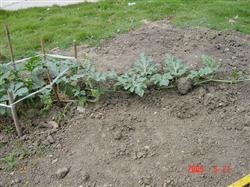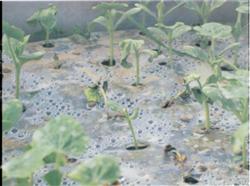The key to artificial pollination of watermelon

(1) the flower pollinates the female flower stalk gently to expose the stigma, then select the male flower that blooms on the same day, pick it off together with the petal, turn out the petals and expose the stamens, and gently smear the pollen on the stigma of the female flower in the node position of the melon, so that the pollen is evenly scattered on the stigma. Generally, a male flower can give 2 or 4 female flowers. (2) the brush is dipped in powder to pick the male flowers that bloom that day, concentrate the pollen in a clean vessel (such as a petri dish or bowl) and mix it, then dip the pollen with a soft brush or a small brush, aim at the stigma of the female flower, and gently apply it a few times. You can see that the stigma has obvious yellow pollen. (3) main points for pollination on cloudy and rainy days if there are more rainy days during watermelon flowering, which affects normal pollination, female and male flowers can be put on paper caps (or small plastic bags) to prevent rain one day before rain. The paper cap (or small plastic bag) was removed during pollination, and the female flowers were still protected by paper cap (or small plastic bag) after pollination, and removed 3 days later. There were showers during flowering and pollination, and pollination was carried out 2 hours after the rain. Pollination should be completed within 3 hours, and there will be light rain within 3 hours. No matter which method is used, different colors of cards should be hung on the pollinated melon node after pollination. In this way, it can not only confirm that it has been pollinated and prevent repeated pollination, but also facilitate the determination of the maturity of watermelon and timely harvest. (4) check the effect of artificial pollination in the afternoon after pollination, if the fruiting stalk of the female flower is bent and sagging, the front end of the ovary begins to touch the ground, indicating that pollination is successful. If the stalk of the female flower is still upward or straight forward, there is generally no sign of pollination. At this time, attention should be paid to cleaning the marker on the plant and re-selecting the female flower for pollination.
- Prev

Technology of pressing vine and pruning of watermelon
Vine pressing and pruning are the main technical links in watermelon cultivation and management. through vine pressing and pruning, land and light energy can be effectively used to regulate and inhibit the growth and distribution of watermelon stems, so as to improve the quality and yield of watermelon. 1. Invert seedlings and cultivate soil in the rhizosphere before pressing the vine. 6 true leaves appeared in the seedling and began to be smoked.
- Next

What problems should be paid attention to in watermelon seedling management?
What problems should be paid attention to in watermelon seedling management? (1) temperature management: in temperature management, two tendencies should be avoided, one is that they do not dare to uncover the film for ventilation, for fear that the seedlings will be frozen, resulting in high temperature and humidity in the seedling bed, causing the seedlings to grow excessively; the other is that the ventilation rate is too large, which makes the temperature in the bed too low, causing the seedlings to grow slowly.
Related
- Moge, come on! The staff of the peasant association in the producing area of cantaloupe were frightened when the crowd gathered.
- Causes and Solutions of low Fruit setting rate of Apple
- Symptoms and control measures of passion fruit virus disease
- Fruit growing lesson: how do apple orchards keep high yields?
- Can you build orchards in the mountains? What are the pros and cons?
- How to manage the coloring period of Crisson grape?
- This paper introduces the processing technology of two kinds of fig products.
- How much is a month for retired teachers in rural areas by 2020?
- How can strawberry planting increase sugar content? We should pay attention to management in many aspects.
- What are the cultivation techniques on how to improve the yield of golden fruit?

